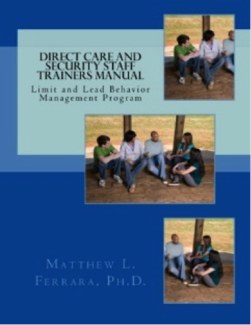Limit and Lead is a complete program for conduct disordered youth and juvenile delinquents. The Limit & Lead Program consists of a behavior management component and cognitive rehabilitation interventions. This book is the trainer’s manual used to orchestrate training given to direct care and security staff in a residential facility, institution, halfway house, or group home for youth with acting out behavior problems. The Limit & Lead Behavior Management Training Program was first used three decades ago in the Texas Youth Commission. Since that time it has been used by the Arizona Department of Juvenile Corrections and private agencies such as the San Marcos Treatment Center and Youth Development Institute. Training experts are available throughout the United States to help with implementation of the Limit & Lead Program. For more information visit https://www.doctorferrara.com
The Trainer’s Manual consists of forty-two lesson plans used for teaching the Limit & Lead Behavior Management Training Program. The Trainer’s Manual uses the content in Trainee Handout as the script that the trainer will follow while training new hires and retraining existing direct care and security staff.
There are two types of lessons in the Trainer’s Manual. Didactic Lesson plans are used to teach trainees important information about conduct disordered youth and how to manage them. Role Play Lessons are used to give trainees the opportunity to practice the skills they will need to use when working with youths.
The Trainer’s Manual also contains rating forms to be used to evaluate trainees as they role-play skills taught during training. A comprehensive test for evaluating knowledge acquisition is also included.
Limit and Lead Behavior Management Trainer’s Manual Table of Contents
- INTRODUCTION
- 1
- LESSON PLANS
- Lesson 1: Welcome and Overview
- 17
- Lesson 2: The Role of Behavior Management
- 19
- Lesson 3: The Research Basis of Behavior Management
- 21
- Lesson 4: The Limit & Lead Behavior Management Approach
- 28
- Lesson 5: Your Job: Confront and Teach
- 29
- Lesson 6: Active Listening
- 30
- Lesson 7: Constructive Responding
- 33
- Lesson 8: When and How to Limit
- 35
- Lesson 9: Definitions of Techniques for Setting Limits
- 37
- Lesson 10: Directive Statements and Role-Playing
- 38
- Lesson 11: When and How to Lead
- 39
- Lesson 12: Definitions of Techniques for Leading
- 40
- Lesson 13: Teaching Emotions
- 41
- Lesson 14: The Why Sandwich
- 42
- Lesson 15: The Why Sandwich Worksheet
- 43
- Lesson 16: Role-Playing: Lead and Teach
- 44
- Lesson 17: Checking
- 45
- Lesson 18: Behavior Groups
- 46
- Lesson 19: Role-Playing: Behavior Group
- 50
- Lesson 20: Thinking Leads to Emotions and Behaviors
- 53
- Lesson 21: Thinking Errors
- 55
- Lesson 22: Criminal Outlets
- 57
- Lesson 23: The Offense Cycle and Stair Steps
- 59
- Lesson 24: ACE: Self-Control Techniques
- 60
- Lesson 25: Huddle-Up
- 61
- Lesson 26: Role-Playing: Huddle-Up
- 64
- Lesson 27: Anatomy of a Crisis
- 65
- Lesson 28: Crisis Intervention
- 66
- Lesson 29: De-escalating a Crisis
- 67
- Lesson 30: Anatomy of a Delinquent Game
- 69
- Lesson 31: How to Avoid Becoming a Victim: Part I
- 71
- Lesson 32: How to Avoid Becoming a Victim: Part II
- 73
- Lesson 33: Coping with Delinquent Games: Small Group Discussion
- 74
- Lesson 34: How to Prevent Delinquent Games
- 75
- Lesson 35: How to Overcome Delinquent Games
- 76
- Lesson 36: How Delinquent Environments Develop
- 77
- Lesson 37: Large Groups
- 78
- Lesson 38: Role-Play: Large Groups
- 80
- Lesson 39: Shut-Downs
- 82
- Lesson 40: Target Behaviors
- 83
- Lesson 41: Helping Youths reduce Target Behaviors
- 84
- Lesson 42: Characteristics of Staff Who Work Effectively with Youth
- 85
- MONITORING FORMS
- Direct Care Staff Evaluation Form
- 89
- Behavior Group Monitoring Form
- 91
- Huddle-Up Evaluation Form
- 96
- PROFICIENCY EXAM
- Proficiency Examination
- 101
- Proficiency Examination Key
- 112
